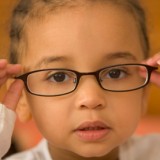Kids’ Astigmatism
Just as in adults, astigmatism can also affect children. A study by the National Institutes of Health found that roughly 10 percent of children have astigmatism. Kids’ astigmatism is often congenital, or present at birth. However, astigmatism may also occur after an eye injury or operation. Astigmatism is typically easier to identify in adults, as they are more capable of accurately discussing and expressing symptoms. It is important to be aware of kids’ astigmatism symptoms so that children can receive prompt treatment.
What Is Astigmatism?
Astigmatism is a type of refractive error that occurs when the surface of the eye is irregularly shaped. The primary side effect of astigmatism is blurred and distorted vision. Blurred vision occurs because the light entering the eye cannot be focused correctly onto the retina due to the improperly shaped eye. Astigmatism is not contagious, and is a fairly common condition.
Types of Astigmatism
There are two types of astigmatism: corneal astigmatism and lenticular astigmatism. As indicated by the name, corneal astigmatism occurs when the cornea is irregularly shaped. Lenticular astigmatism occurs when the lens of the eye is irregularly shaped. Irregularities in shape typically occur as one half of the cornea or lens being flatter or steeper than the other side.
Kids’ Astigmatism Symptoms
Astigmatism may be particularly difficult to detect in children. Parents, teachers, and other adults should be aware of the symptoms of kids’ astigmatism so that the condition can be diagnosed as soon as possible. Failure to diagnose kids’ astigmatism can lead to more severe vision and overall health issues as the child ages.
The following symptoms may indicate the presence of kids’ astigmatism:
- Photophobia, or sensitivity to light
- Distorted or blurred vision at any distance
- Excessive eye straining in order to see
- Headaches and dizziness due to poorer vision
- Frequent closing of the eyes
- Excessive squinting in an attempt to see better
Kids’ Astigmatism Treatment
In most cases, kids’ astigmatism can be treated with eyeglasses or contact lenses, depending on the age and condition of the patient. Optometrists may prefer to prescribe contact lenses to kids who experience headaches, eye strain, and vision distortion due to frequent head tilting to see clearly.
Astigmatism Surgery
Eye surgery may be needed to treat severe cases. Kids’ astigmatism eye surgery includes LASIK (laser-assisted in situ keratomileusis) surgery and PK surgery (photorefractive keratectomy). LASIK surgery uses a laser beam to remove part of the corneal tissue, thus reshaping the cornea. PK surgery also reshapes the cornea, but without the use of a laser.
Sources:
http://www.nei.nih.gov/news/statements/pediatric.asp
http://pediatrics.med.nyu.edu/conditions-we-treat/conditions/astigmatism

















